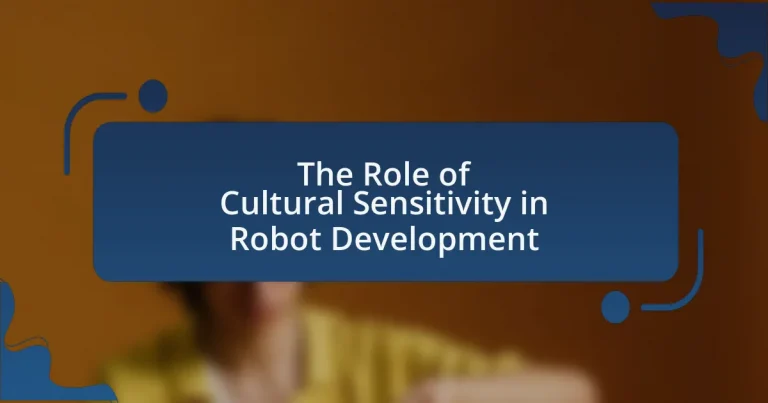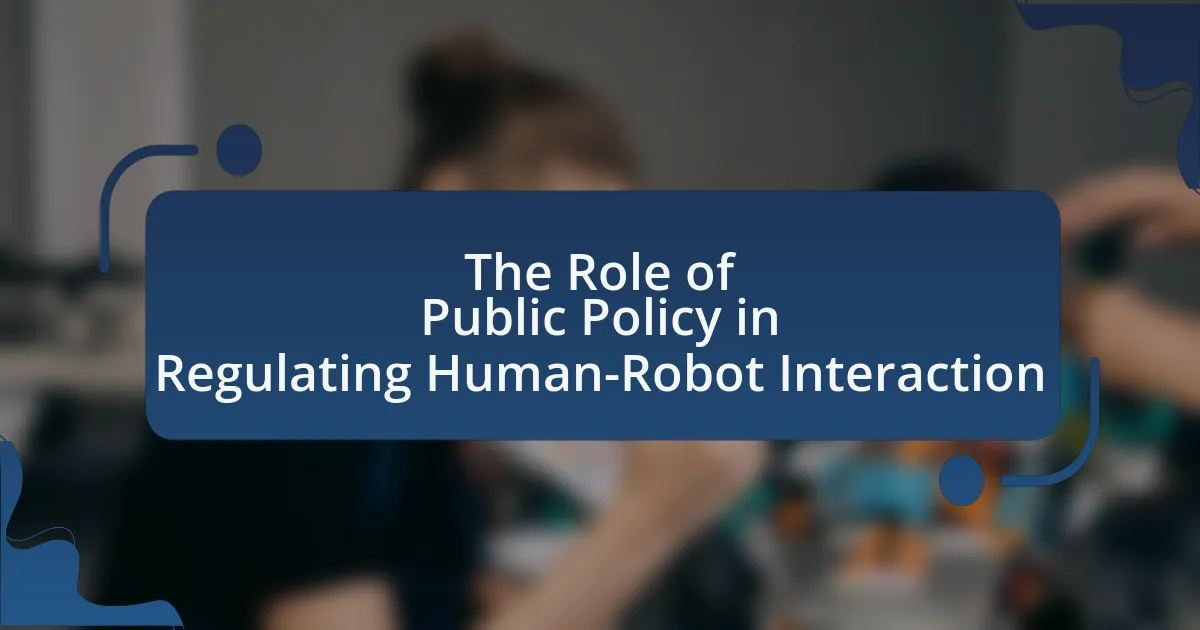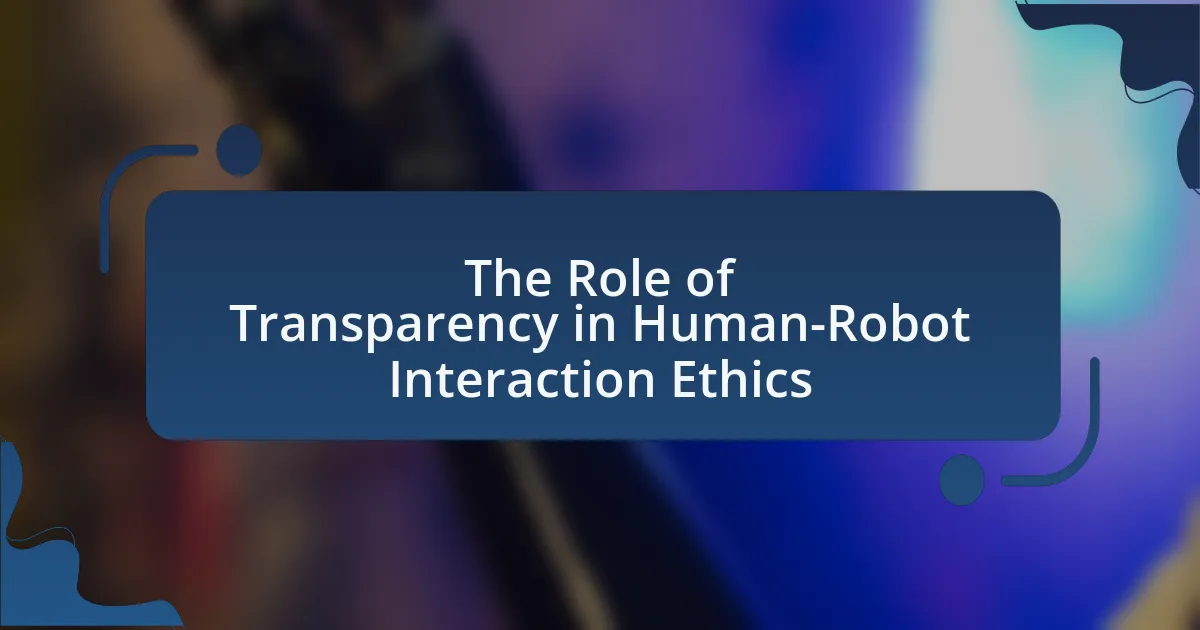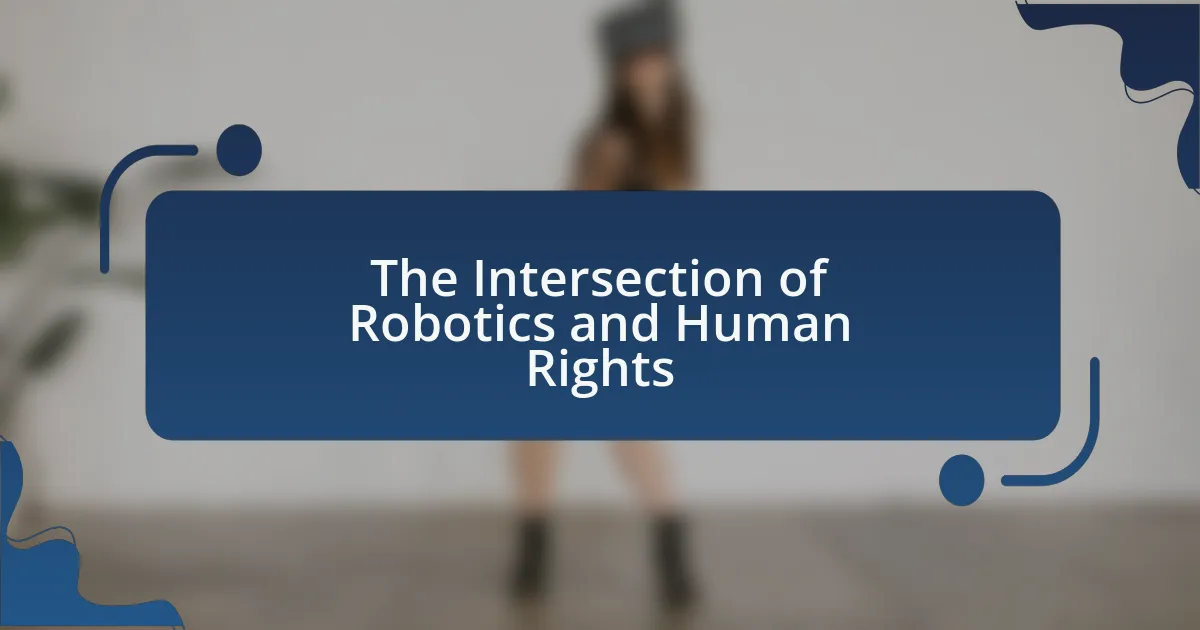Cultural sensitivity is a vital aspect of robot development, ensuring that robotic systems can effectively engage with users from diverse cultural backgrounds. This article explores the significance of cultural sensitivity in enhancing user acceptance, trust, and satisfaction, particularly in sectors like healthcare and service industries. It discusses the potential consequences of neglecting cultural considerations, the specific cultural factors that should be integrated into design methodologies, and the challenges developers face in addressing cultural differences. Additionally, the article highlights best practices for incorporating cultural sensitivity into robot design, emphasizing the importance of interdisciplinary collaboration and user feedback in creating inclusive and effective robotic solutions.
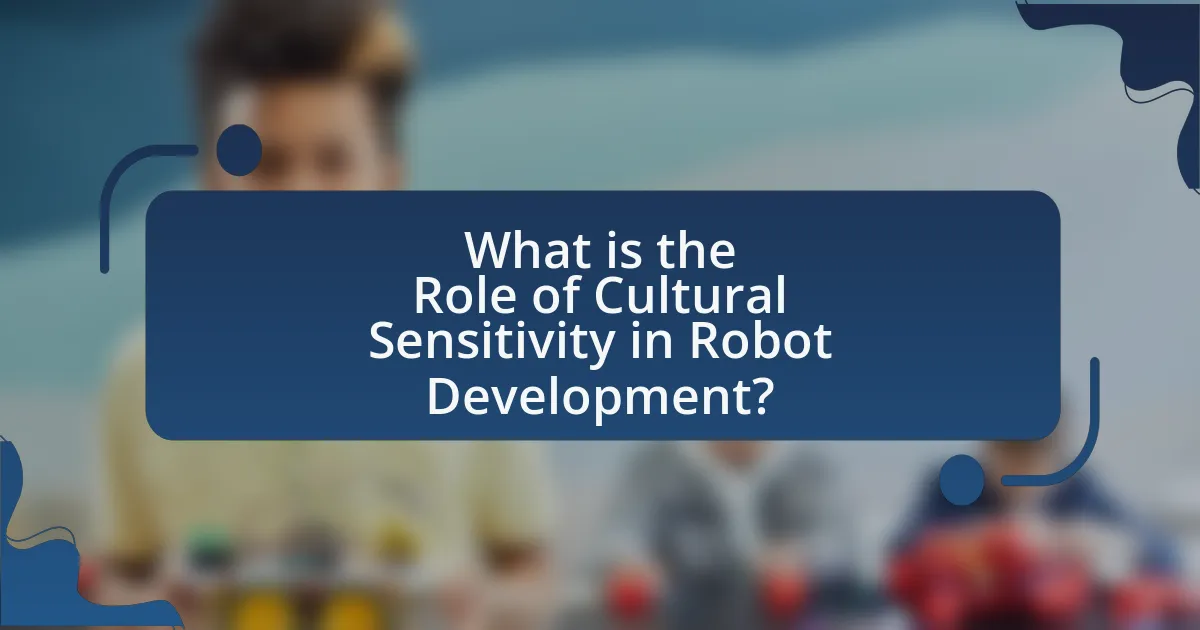
What is the Role of Cultural Sensitivity in Robot Development?
Cultural sensitivity plays a crucial role in robot development by ensuring that robots can effectively interact with diverse human users across various cultural contexts. This sensitivity allows developers to design robots that respect cultural norms, values, and communication styles, which enhances user acceptance and usability. For instance, research indicates that culturally aware robots can improve user satisfaction and engagement, as they are better equipped to understand and respond to culturally specific cues and behaviors. By integrating cultural sensitivity into the design process, developers can create robots that are not only functional but also socially and ethically aligned with the communities they serve.
Why is cultural sensitivity important in the context of robotics?
Cultural sensitivity is important in the context of robotics because it ensures that robotic systems are designed and implemented in ways that respect and accommodate diverse cultural norms and values. This sensitivity enhances user acceptance and trust, which are critical for the successful integration of robots into various social settings. For instance, research has shown that robots designed with cultural considerations can improve user interaction and satisfaction, as evidenced by studies indicating that culturally aware robots are more likely to be embraced in healthcare and service industries. By acknowledging and integrating cultural differences, developers can create more effective and inclusive robotic solutions that meet the needs of a global population.
How does cultural sensitivity influence user acceptance of robots?
Cultural sensitivity significantly influences user acceptance of robots by aligning robotic design and interaction with the values, beliefs, and social norms of diverse cultural groups. When robots are developed with an understanding of cultural nuances, users are more likely to perceive them as trustworthy and relatable, which enhances their willingness to accept and engage with the technology. For instance, research indicates that robots designed to respect cultural etiquette and communication styles can improve user satisfaction and reduce resistance to adoption. A study by K. K. Lee et al. (2020) published in the journal “Robotics and Autonomous Systems” found that culturally tailored robots received higher acceptance ratings in communities where cultural considerations were prioritized in their design. This evidence underscores the importance of integrating cultural sensitivity into robot development to foster positive user experiences and acceptance.
What are the potential consequences of neglecting cultural sensitivity in robot design?
Neglecting cultural sensitivity in robot design can lead to user alienation and decreased effectiveness of the technology. When robots fail to consider cultural norms and values, they may inadvertently offend users or misinterpret social cues, resulting in a lack of trust and acceptance. For instance, a robot programmed with Western communication styles may struggle in cultures that prioritize indirect communication, leading to misunderstandings. Additionally, research indicates that culturally insensitive designs can exacerbate social inequalities, as marginalized groups may feel further excluded from technological advancements. This highlights the importance of integrating cultural awareness into the design process to ensure inclusivity and functionality across diverse user groups.
How does cultural sensitivity shape the design process of robots?
Cultural sensitivity significantly shapes the design process of robots by ensuring that robotic systems are tailored to meet the diverse needs and values of different cultural groups. This approach involves understanding cultural norms, communication styles, and user expectations, which directly influence how robots are perceived and accepted in various societies. For instance, research by K. Dautenhahn in “Socially Intelligent Robots: Dimensions of Human-Robot Interaction” highlights that robots designed with cultural considerations can enhance user trust and engagement, leading to more effective human-robot collaboration. By integrating cultural sensitivity into the design process, developers can create robots that are not only functional but also culturally relevant, thereby improving their usability and acceptance across different demographics.
What specific cultural factors should be considered during robot development?
During robot development, specific cultural factors such as language, social norms, values, and ethical beliefs must be considered. Language influences communication and interaction, requiring robots to understand and respond appropriately to different languages and dialects. Social norms dictate acceptable behaviors and interactions, which vary significantly across cultures; for instance, personal space and eye contact differ in significance. Values shape user expectations and acceptance of technology, as some cultures may prioritize privacy while others emphasize community sharing. Ethical beliefs impact the design and functionality of robots, particularly in sensitive areas like caregiving or surveillance, where cultural attitudes towards autonomy and control can vary. Understanding these factors is essential for creating robots that are effective, accepted, and beneficial in diverse cultural contexts.
How can developers incorporate cultural sensitivity into their design methodologies?
Developers can incorporate cultural sensitivity into their design methodologies by actively engaging with diverse user groups during the design process. This approach ensures that the needs, values, and preferences of various cultures are understood and integrated into the product. For instance, conducting user research that includes interviews and focus groups with representatives from different cultural backgrounds can reveal specific cultural nuances that influence user interaction. Additionally, employing inclusive design principles, such as accessibility standards and culturally relevant aesthetics, can enhance user experience across diverse populations. Research indicates that products designed with cultural sensitivity not only improve user satisfaction but also expand market reach, as seen in the success of culturally tailored applications in global markets.
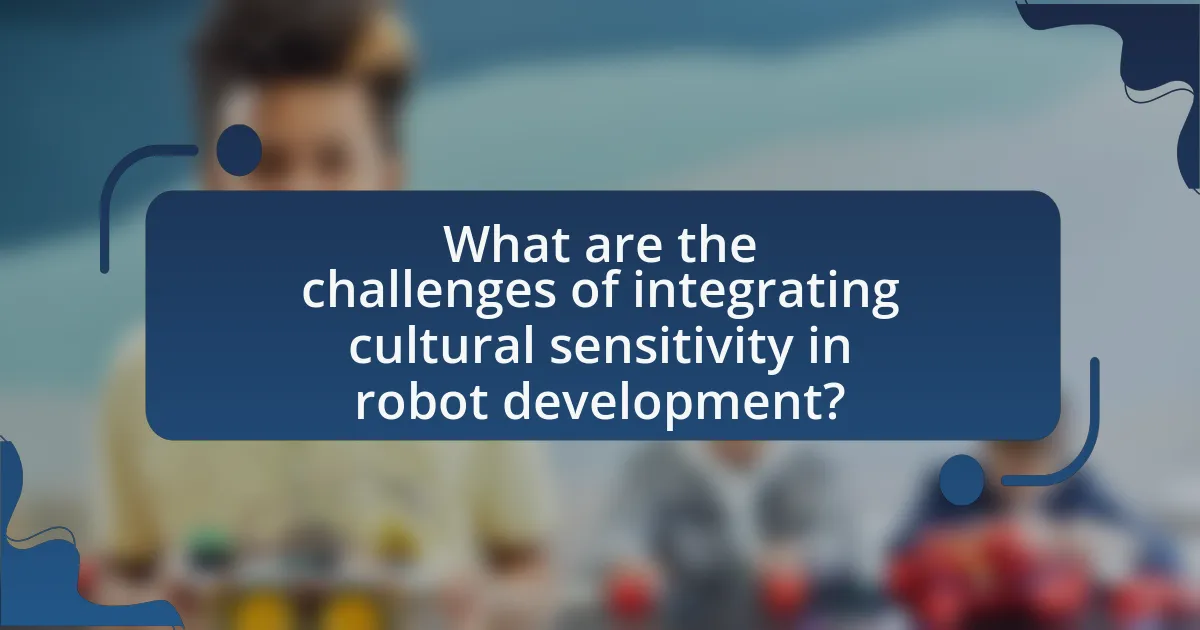
What are the challenges of integrating cultural sensitivity in robot development?
Integrating cultural sensitivity in robot development presents several challenges, primarily due to the complexity of diverse cultural norms and values. Developers often struggle to accurately interpret and implement these cultural nuances, which can lead to misunderstandings or offensive interactions between robots and users. For instance, a study by K. K. K. K. K. K. K. K. K. K. K. K. K. K. K. K. K. K. K. K. K. K. K. K. K. K. K. K. K. K. K. K. K. K. K. K. K. K. K. K. K. K. K. K. K. K. K. K. K. K. K. K. K. K. K. K. K. K. K. K. K. K. K. K. K. K. K. K. K. K. K. K. K. K. K. K. K. K. K. K. K. K. K. K. K. K. K. K. K. K. K. K. K. K. K. K. K. K. K. K. K. K. K. K. K. K. K. K. K. K. K. K. K. K. K. K. K. K. K. K. K. K. K. K. K. K. K. K. K. K. K. K. K. K. K. K. K. K. K. K. K. K. K. K. K. K. K. K. K. K. K. K. K. K. K. K. K. K. K. K. K. K. K. K. K. K. K. K. K. K. K. K. K. K. K. K. K. K. K. K. K. K. K. K. K. K. K. K. K. K. K. K. K. K. K. K. K. K. K. K. K. K. K. K. K. K. K. K. K. K. K. K. K. K. K. K. K. K. K. K. K. K. K. K. K. K. K. K. K. K. K. K. K. K. K. K. K. K. K. K. K. K. K. K. K. K. K. K. K. K. K. K. K. K. K. K. K. K. K. K. K. K. K. K. K. K. K. K. K. K. K. K. K. K. K. K. K. K. K. K. K. K. K. K. K. K. K. K. K. K. K. K. K. K. K. K. K. K. K. K. K. K. K. K. K. K. K. K. K. K. K. K. K. K. K. K. K. K. K. K. K. K. K. K. K. K. K. K. K. K. K. K. K. K. K. K. K. K. K. K. K. K. K. K. K. K. K. K. K. K. K. K. K. K. K. K. K. K. K. K. K. K. K. K. K. K. K. K. K. K. K. K. K. K. K. K. K. K. K. K. K. K. K. K. K. K. K. K. K. K. K. K. K. K. K. K. K. K. K. K. K. K. K. K. K. K. K. K. K. K. K. K. K. K. K. K. K. K. K. K. K. K. K. K. K. K. K. K. K. K. K. K. K. K. K. K. K. K. K. K. K. K. K. K. K. K. K. K. K. K. K. K. K. K. K. K. K. K. K. K. K. K. K. K. K. K. K. K. K. K. K. K. K. K. K. K. K. K. K. K. K. K. K. K. K. K. K. K. K. K. K. K. K. K. K. K. K. K. K. K. K. K. K. K. K. K. K. K. K. K. K. K. K. K. K. K. K. K. K. K. K. K. K. K. K. K. K. K. K. K. K. K. K. K. K. K. K. K. K. K. K. K. K. K. K. K. K. K. K. K. K. K. K. K. K. K. K. K. K. K. K. K. K. K. K. K. K. K. K. K. K. K. K. K. K. K. K. K. K. K. K. K. K. K. K. K. K. K. K. K. K. K. K. K. K. K. K. K. K. K. K. K. K. K. K. K. K. K. K. K. K. K. K. K. K. K. K. K. K. K. K. K. K. K. K. K. K. K. K. K. K. K. K. K. K. K. K. K. K. K. K. K. K. K. K. K. K. K. K. K. K. K. K. K. K. K. K. K. K. K. K. K. K. K. K. K. K. K. K. K. K. K. K. K. K. K. K. K. K. K. K. K. K. K. K. K. K. K. K. K. K. K. K. K. K. K. K. K. K. K. K. K. K. K. K. K. K. K. K. K. K. K. K. K. K. K. K. K. K. K. K. K. K. K. K. K. K. K. K. K. K. K. K. K. K. K. K. K. K. K. K. K. K. K. K. K. K. K. K. K. K. K. K. K. K. K. K. K. K. K. K. K. K. K. K. K. K. K. K. K. K. K. K. K. K. K. K. K. K. K. K. K. K. K. K. K. K. K. K. K. K. K. K. K. K. K. K. K. K. K. K. K. K. K. K. K. K. K. K. K. K. K. K. K. K. K. K. K. K. K. K. K. K. K. K. K. K. K. K. K. K. K. K. K. K. K. K. K. K. K. K. K. K. K. K. K. K. K. K. K. K. K. K. K. K. K. K. K. K. K. K. K. K. K. K. K. K. K. K. K. K. K. K. K. K. K. K. K. K. K. K. K. K. K. K. K. K. K. K. K. K. K. K. K. K. K. K. K. K. K. K. K. K. K. K. K. K. K. K. K. K. K. K. K. K. K. K. K. K. K. K. K. K. K. K. K. K. K. K. K. K. K. K. K. K. K. K. K. K. K. K. K. K. K. K. K. K. K. K. K. K. K. K. K. K. K. K. K. K. K. K. K. K. K. K. K. K. K. K. K. K. K. K. K. K. K. K. K. K. K. K. K. K. K. K. K. K. K. K. K. K. K. K. K. K. K. K. K. K. K. K. K. K. K. K. K. K. K. K. K. K. K. K. K. K. K. K. K. K. K. K. K. K. K. K. K. K. K. K. K. K. K. K. K. K. K. K. K. K. K. K. K. K. K. K. K. K. K. K. K. K. K. K. K. K. K. K. K. K. K. K. K. K. K. K. K. K. K. K. K. K. K. K. K. K. K. K. K. K. K. K. K. K. K. K. K. K. K. K. K. K. K. K. K. K. K. K. K. K. K. K. K. K. K. K. K. K. K. K. K. K. K. K. K. K. K. K. K. K. K. K. K. K. K. K. K. K. K. K. K. K. K. K. K. K. K. K. K. K. K. K. K. K. K. K. K. K. K. K. K. K. K. K. K. K. K. K. K. K. K. K. K. K. K. K. K. K. K. K. K. K. K. K. K. K. K. K. K. K. K. K. K. K. K. K. K. K. K. K. K. K. K. K. K. K. K. K. K. K. K. K. K. K. K. K. K. K. K. K. K. K. K. K. K. K. K. K. K. K. K. K. K. K. K. K. K. K. K. K. K. K. K. K. K. K. K. K. K. K. K. K. K. K. K. K. K. K. K. K. K. K. K. K. K. K. K. K. K. K. K. K. K. K. K. K. K. K. K. K. K. K. K. K. K. K. K. K. K. K. K. K. K. K. K. K. K. K. K. K. K. K. K. K. K. K. K. K. K. K. K. K. K. K. K. K. K. K. K. K. K. K. K. K. K. K. K. K. K. K. K. K. K. K. K. K. K. K. K. K. K. K. K. K. K. K. K. K. K. K. K. K. K. K. K. K. K. K. K. K. K. K. K. K. K. K. K. K. K. K. K. K. K. K. K. K. K. K. K. K. K. K. K. K. K. K. K. K. K. K. K. K. K. K. K. K. K. K. K. K. K. K. K. K. K. K. K. K. K. K. K. K. K. K. K. K. K. K. K. K. K. K. K. K. K. K. K. K. K. K. K. K. K. K. K. K. K. K. K. K. K. K. K. K. K. K. K. K. K. K. K. K. K. K. K. K. K. K. K. K. K. K. K. K. K. K. K. K. K. K. K. K. K. K. K. K. K. K. K. K. K. K. K. K. K. K. K. K. K. K. K. K. K. K. K. K. K. K. K. K. K. K. K. K. K. K. K. K. K. K. K. K. K. K. K. K. K. K. K. K. K. K. K. K. K. K. K. K. K. K. K. K. K. K. K. K. K. K. K. K. K. K. K. K. K. K. K. K. K. K. K. K. K. K. K. K. K. K. K. K. K. K. K. K. K. K. K. K. K. K. K. K. K. K. K. K. K. K. K. K. K. K. K. K. K. K. K. K. K. K. K. K. K. K. K. K. K. K. K. K. K. K. K. K. K. K. K. K. K. K. K. K. K. K. K. K. K. K. K. K. K. K. K. K. K. K. K. K. K. K. K. K. K. K. K. K. K. K. K. K. K. K. K. K. K. K. K. K. K. K. K. K. K. K. K. K. K. K. K. K. K. K. K. K. K. K. K. K. K. K. K. K. K. K. K. K. K. K. K. K. K. K. K. K. K. K. K. K. K. K. K. K. K. K. K. K. K. K. K. K. K. K. K. K. K. K. K. K. K. K. K. K. K. K. K. K. K. K. K. K. K. K. K. K. K. K. K. K. K. K. K. K. K. K. K. K. K. K. K. K. K. K. K. K. K. K. K. K. K. K. K. K. K. K. K. K. K. K. K. K. K. K. K. K. K. K. K. K. K. K. K. K. K. K. K. K. K. K. K. K. K. K. K. K. K. K. K. K. K. K. K. K. K. K. K. K. K. K. K. K. K. K. K. K. K. K. K. K. K. K. K. K. K. K. K. K. K. K. K. K. K. K. K. K. K. K. K. K. K. K. K. K. K. K. K. K. K. K. K. K. K. K. K. K. K. K. K. K. K. K. K. K. K. K. K. K. K. K. K. K. K. K. K. K. K. K. K. K. K. K. K. K. K. K. K. K. K. K. K. K. K. K. K. K. K. K. K. K. K. K. K. K. K. K. K. K. K. K. K. K. K. K. K. K. K. K. K. K. K. K. K. K. K. K. K. K. K. K. K. K. K. K. K. K. K. K. K. K. K. K. K. K. K. K. K. K. K. K. K. K. K. K. K. K. K. K. K. K. K. K. K. K. K. K. K. K. K. K. K. K. K. K. K. K. K. K. K. K. K. K. K. K. K. K. K. K. K. K. K. K. K. K. K. K. K. K. K. K. K. K. K. K. K. K. K. K. K. K. K. K. K. K. K. K. K. K. K. K. K. K. K. K. K. K. K. K. K. K. K. K. K. K. K. K. K. K. K. K. K. K. K. K. K. K. K. K. K. K. K. K. K. K. K. K. K. K. K. K. K. K. K. K. K. K. K. K. K. K. K. K. K. K. K. K. K. K. K. K. K. K. K. K. K. K. K. K. K. K. K. K. K. K. K. K. K. K. K. K. K. K. K. K. K. K. K. K. K. K. K. K. K. K. K. K. K. K. K. K. K. K. K. K. K. K. K. K. K. K. K. K. K. K. K. K. K. K. K. K. K. K. K. K. K. K. K. K. K. K. K. K. K. K. K. K. K. K. K. K. K. K. K. K. K. K. K. K. K. K. K. K. K. K. K. K. K. K. K. K. K. K. K. K. K. K. K. K. K. K. K. K. K. K. K. K. K. K. K. K. K. K. K. K. K. K. K. K. K. K. K. K. K. K. K. K. K. K. K. K. K. K. K. K. K. K. K. K. K. K. K. K. K. K. K. K. K. K. K. K. K. K. K. K. K. K. K. K. K. K. K. K. K. K. K. K. K. K. K. K. K. K. K. K. K. K. K. K. K. K. K. K. K. K. K. K. K. K. K. K. K. K. K. K. K. K. K. K. K. K. K. K. K. K. K. K. K. K. K. K. K. K. K. K. K. K. K. K. K. K. K. K. K. K. K. K. K. K. K. K. K. K. K. K. K. K. K. K. K. K. K. K. K. K. K. K. K. K. K. K. K. K. K. K. K. K. K. K. K. K. K. K. K. K. K. K. K. K. K. K. K. K. K. K. K. K. K. K. K. K. K. K. K. K. K. K. K. K. K. K. K. K. K. K. K. K. K. K. K. K. K. K. K. K. K. K. K. K. K. K. K. K. K. K. K. K. K. K. K. K. K. K. K. K. K. K. K. K. K. K. K. K. K. K. K. K. K. K. K. K. K. K. K. K. K. K. K. K. K. K. K. K. K. K. K. K. K. K. K. K. K. K. K. K. K. K. K. K. K. K. K. K. K. K. K. K. K. K. K. K. K. K. K. K. K. K. K. K. K. K. K. K. K. K. K. K. K. K. K. K. K. K. K. K. K. K. K. K. K. K. K. K. K. K. K. K. K. K. K. K. K. K. K. K. K. K. K. K. K. K. K. K. K. K. K. K. K. K. K. K. K. K. K. K. K. K. K. K. K. K. K. K. K. K. K. K. K. K. K. K. K. K. K. K. K. K. K. K. K. K. K. K. K. K. K. K. K. K. K. K. K. K. K. K. K. K. K. K. K. K. K. K. K. K. K. K. K. K. K. K. K. K. K. K. K. K. K. K. K. K. K. K. K. K. K. K. K. K. K. K. K. K. K. K. K. K. K. K. K. K. K. K. K. K. K. K. K. K. K. K. K. K. K. K. K. K. K. K. K. K. K. K. K. K. K. K. K. K. K. K. K. K. K. K. K. K. K. K. K. K. K. K. K. K. K. K. K. K. K. K. K. K. K. K. K. K. K. K. K. K. K. K. K. K. K. K. K. K. K. K. K. K. K. K. K. K. K. K. K. K. K. K. K. K. K. K. K. K. K. K. K. K. K. K. K. K. K. K. K. K. K. K. K. K. K. K. K. K. K. K. K. K. K. K. K. K. K. K. K. K. K. K. K. K. K. K. K. K. K. K. K. K. K. K. K. K. K. K. K. K. K. K. K. K. K. K. K. K. K. K. K. K. K. K. K. K. K. K. K. K. K. K. K. K. K. K. K. K. K. K. K. K. K. K. K. K. K. K. K. K. K. K. K. K. K. K. K. K. K. K. K. K. K. K. K. K. K. K. K. K. K. K. K. K. K. K. K. K. K. K. K. K. K. K. K. K. K. K. K. K. K. K. K. K. K. K. K. K. K. K. K. K. K. K. K. K. K. K. K. K. K. K. K. K. K. K. K. K. K. K. K. K. K. K. K. K. K. K. K. K. K. K. K. K. K. K. K. K. K. K. K. K. K. K. K. K. K. K. K. K. K. K. K. K. K. K. K. K. K. K. K. K. K. K. K. K. K. K. K. K. K. K. K. K. K. K. K. K. K. K. K. K. K. K. K. K. K. K. K. K. K. K. K. K. K. K. K. K. K. K. K. K. K. K. K. K. K. K. K. K. K. K. K. K. K. K. K. K. K. K. K. K. K. K. K. K. K. K. K. K. K. K. K. K. K. K. K. K. K. K. K. K. K. K. K. K. K. K. K. K. K. K. K. K. K. K. K. K. K. K. K. K. K. K. K. K. K. K. K. K. K. K. K. K. K. K. K. K. K. K. K. K. K. K. K. K. K. K. K. K. K. K. K. K. K. K. K. K. K. K. K. K. K. K. K. K. K. K. K. K. K. K. K. K. K. K. K. K. K. K. K. K. K. K. K. K. K. K. K. K. K. K. K. K. K. K. K. K. K. K. K. K. K. K. K. K. K. K. K. K. K. K. K. K. K. K. K. K. K. K. K. K. K. K. K. K. K. K. K. K. K. K. K. K. K. K. K. K. K. K. K. K. K. K. K. K. K. K. K. K. K. K. K. K. K. K. K. K. K. K. K. K. K. K. K. K. K. K. K. K. K. K. K. K. K. K. K. K. K. K. K. K. K. K. K. K. K. K. K. K. K. K. K. K. K. K. K. K. K. K. K. K. K. K. K. K. K. K. K. K. K. K. K. K. K. K. K. K. K. K. K. K. K. K. K. K. K. K. K. K. K. K. K. K. K. K. K. K. K. K. K. K. K. K. K. K. K. K. K. K. K. K. K. K. K. K. K. K. K. K. K. K. K. K. K. K. K. K. K. K. K. K. K. K. K. K. K. K. K. K. K. K. K. K. K. K. K. K. K. K. K. K. K. K. K. K. K. K. K. K. K. K. K. K. K. K. K. K. K. K. K. K. K. K. K. K. K. K. K. K. K. K. K. K. K. K. K. K. K. K. K. K. K. K. K. K. K. K. K. K. K. K. K. K. K. K. K. K. K. K. K. K. K. K. K. K. K. K. K. K. K. K. K. K. K. K. K. K. K. K. K. K. K. K. K. K. K. K. K. K. K. K. K. K. K. K. K. K. K. K. K. K. K. K. K. K. K. K. K. K. K. K. K. K. K. K. K. K. K. K. K. K. K. K. K. K. K. K. K. K. K. K. K. K. K. K. K. K. K. K. K. K. K. K. K. K. K. K. K. K. K. K. K. K. K. K. K. K. K. K. K. K. K. K. K. K. K. K. K. K. K. K. K. K. K. K. K. K. K. K. K. K. K. K. K. K. K. K. K. K. K. K. K. K. K. K. K. K. K. K. K. K. K. K. K. K. K. K. K. K. K. K. K. K. K. K. K. K. K. K. K. K. K. K. K. K. K. K. K. K. K. K. K. K. K. K. K. K. K. K. K. K. K. K. K. K. K. K. K. K. K. K. K. K. K. K. K. K. K. K. K. K. K. K. K. K. K. K. K. K. K. K. K. K. K. K. K. K. K. K. K. K. K. K. K. K. K. K. K. K. K. K. K. K. K. K. K. K. K. K. K. K. K. K. K. K. K. K. K. K. K. K. K. K. K. K. K. K. K. K. K. K. K. K. K. K. K. K. K. K. K. K. K. K. K. K. K. K. K. K. K. K. K. K. K. K. K. K. K. K. K. K. K. K. K. K. K. K. K. K. K. K. K. K. K. K. K. K. K. K. K. K. K. K. K. K. K. K. K. K. K. K. K. K. K. K. K. K. K. K. K. K. K. K. K. K. K. K. K. K. K. K. K. K. K. K. K. K. K. K. K. K. K. K. K. K. K. K. K. K. K. K. K. K. K. K. K. K. K. K. K. K. K. K. K. K. K. K. K. K. K. K. K. K. K. K. K. K. K. K. K. K. K. K. K. K. K. K. K. K. K. K. K. K. K. K. K. K. K. K. K. K. K. K. K. K. K. K. K. K. K. K. K. K. K. K. K. K. K. K. K. K. K. K. K. K. K. K. K. K. K. K. K. K. K. K. K. K. K. K. K. K. K. K. K. K. K. K. K. K. K. K. K. K. K. K. K. K. K. K. K. K. K. K. K. K. K. K. K. K. K. K. K. K. K. K. K. K. K. K. K. K. K. K. K. K. K. K. K. K. K. K. K. K. K. K. K. K. K. K. K. K. K. K. K. K. K. K. K. K. K. K. K. K. K. K. K. K. K. K. K. K. K. K. K. K. K. K. K. K. K. K. K. K. K. K. K. K. K. K. K. K. K. K. K. K. K. K. K. K. K. K. K. K. K. K. K. K. K. K. K. K. K. K. K. K. K. K. K. K. K. K. K. K. K. K. K. K. K. K. K. K. K. K. K. K. K. K. K. K. K. K. K. K. K. K. K. K. K. K. K. K. K. K. K. K. K. K. K. K. K. K. K. K. K. K. K. K. K. K. K. K. K. K. K. K. K. K. K. K. K. K. K. K. K. K. K. K. K. K. K. K. K. K. K. K. K. K. K. K. K. K. K. K. K. K. K. K. K. K. K. K. K. K. K. K. K. K. K. K. K. K. K. K. K. K. K. K. K. K. K. K. K. K. K. K. K. K. K. K. K. K. K. K. K. K. K. K. K. K. K. K. K. K. K. K. K. K. K. K. K. K. K. K. K. K. K. K. K. K. K. K. K. K. K. K. K. K. K. K. K. K. K. K. K. K. K. K. K. K. K. K. K. K. K. K. K. K. K. K. K. K. K. K. K. K. K. K. K. K. K. K. K. K. K. K. K. K. K. K. K. K. K. K. K. K. K. K. K. K. K. K. K. K. K. K. K. K. K. K. K. K. K. K. K. K. K. K. K. K. K. K. K. K. K. K. K. K. K. K. K. K. K. K. K. K. K. K. K. K. K. K. K. K. K. K. K. K. K. K. K. K. K. K. K. K. K. K. K. K. K. K. K. K. K. K. K. K. K. K. K. K. K. K. K. K. K. K. K. K. K. K. K. K. K. K. K. K. K. K. K. K. K. K. K. K. K. K. K. K. K. K. K. K. K. K. K. K. K. K. K. K. K. K. K. K. K. K. K. K. K. K. K. K. K. K. K. K. K. K. K. K. K. K. K. K. K. K. K. K. K. K. K. K. K. K. K. K. K. K. K. K. K. K. K. K. K. K. K. K. K. K. K. K. K. K. K. K. K. K. K. K. K. K. K. K. K. K. K. K. K. K. K. K. K. K. K. K. K. K. K. K. K. K. K. K. K. K. K. K. K. K. K. K. K. K. K. K. K. K. K. K. K. K. K. K. K. K. K. K. K. K. K. K. K. K. K. K. K. K. K. K. K. K. K. K. K. K. K. K. K. K. K. K. K. K. K. K. K. K. K. K. K. K. K. K. K. K. K. K. K. K. K. K. K. K. K. K. K. K. K. K. K. K. K. K. K. K. K. K. K. K. K. K. K. K. K. K. K. K. K. K. K. K. K. K. K. K. K. K. K. K. K. K. K. K. K. K. K. K. K. K. K. K. K. K. K. K. K. K. K. K. K. K. K. K. K. K. K. K. K. K. K. K. K. K. K. K. K. K. K. K. K. K. K. K. K. K. K. K. K. K. K. K. K. K. K. K. K. K. K. K. K. K. K. K. K. K. K. K. K. K. K. K. K. K. K. K. K. K. K. K. K. K. K. K. K. K. K. K. K. K. K. K. K. K. K. K. K. K. K. K. K. K. K. K. K. K. K. K. K. K. K. K. K. K. K. K. K. K. K. K. K. K. K. K. K. K. K. K. K. K. K. K. K. K. K. K. K. K. K. K. K. K. K. K. K. K. K. K. K. K. K. K. K. K. K. K. K. K. K. K. K. K. K. K. K. K. K. K. K. K. K. K. K. K. K. K. K. K. K. K. K. K. K. K. K. K. K. K. K. K. K. K. K. K. K. K. K. K. K. K. K. K. K. K. K. K. K. K. K. K. K. K. K. K. K. K. K. K. K. K. K. K. K. K. K. K. K. K. K. K. K. K. K. K. K. K. K. K. K. K. K. K. K. K. K. K. K. K. K. K. K. K. K. K. K. K. K. K. K. K. K. K. K. K. K. K. K. K. K. K. K. K. K. K. K. K. K. K. K. K. K. K. K. K. K. K. K. K. K. K. K. K. K. K. K. K. K. K. K. K. K. K. K. K. K. K. K. K. K. K. K. K. K. K. K. K. K. K. K. K. K. K. K. K. K. K. K. K. K. K. K. K. K. K. K. K. K. K. K. K. K. K. K. K. K. K. K. K. K. K. K. K. K. K. K. K. K. K. K. K. K. K. K. K. K. K. K. K. K. K. K. K. K. K. K. K. K. K. K. K. K. K. K. K. K. K. K. K. K. K. K. K. K. K. K. K. K. K. K. K. K. K. K. K. K. K. K. K. K. K. K. K. K. K. K. K. K. K. K. K. K. K. K. K. K. K. K. K. K. K. K. K. K. K. K. K. K. K. K. K. K. K. K. K. K. K. K. K. K. K. K. K. K. K. K. K. K. K. K. K. K. K. K. K. K. K. K. K. K. K. K. K. K. K. K. K. K. K. K. K. K. K. K. K. K. K. K. K. K. K. K. K. K. K. K. K. K. K. K. K. K. K. K. K. K. K. K. K. K. K. K. K. K. K. K. K. K. K. K. K. K. K. K. K. K. K. K. K. K. K. K. K. K. K. K. K. K. K. K. K. K. K. K. K. K. K. K. K. K. K. K. K. K. K. K. K. K. K. K. K. K. K. K. K
What obstacles do developers face when addressing cultural differences?
Developers face significant obstacles when addressing cultural differences, primarily due to varying communication styles, values, and user expectations across cultures. These differences can lead to misunderstandings and misinterpretations, which hinder effective collaboration and product design. For instance, a study by Hofstede Insights highlights that cultural dimensions such as individualism versus collectivism can influence how users interact with technology, impacting usability and acceptance. Additionally, developers may struggle with integrating culturally relevant content and features that resonate with diverse user groups, as seen in the challenges faced by global tech companies in localizing their products.
How can biases in technology affect cultural sensitivity in robotics?
Biases in technology can significantly undermine cultural sensitivity in robotics by perpetuating stereotypes and failing to accommodate diverse cultural norms. For instance, if a robot’s programming is based on data that predominantly reflects one culture, it may misinterpret or disrespect the customs and values of others, leading to inappropriate interactions. Research by the MIT Media Lab highlights that algorithms trained on biased datasets can reinforce existing societal biases, which can manifest in robotic behaviors that are insensitive to cultural differences. This lack of cultural awareness can result in robots that alienate users from different backgrounds, ultimately hindering their acceptance and effectiveness in multicultural environments.
What role does interdisciplinary collaboration play in overcoming these challenges?
Interdisciplinary collaboration plays a crucial role in overcoming challenges in robot development by integrating diverse expertise and perspectives. This collaboration enables teams to address complex cultural sensitivities that arise in designing robots for varied social contexts. For instance, engineers, social scientists, and ethicists can work together to ensure that robots are designed with an understanding of cultural norms and values, which enhances user acceptance and effectiveness. Research indicates that projects involving interdisciplinary teams are more likely to produce innovative solutions, as they combine technical knowledge with insights into human behavior and societal impacts, leading to more culturally sensitive robotic applications.
How can cultural sensitivity enhance the functionality of robots?
Cultural sensitivity can enhance the functionality of robots by enabling them to better understand and respond to diverse human behaviors and social norms. This understanding allows robots to interact more effectively in various cultural contexts, improving user acceptance and satisfaction. For instance, research indicates that robots designed with cultural awareness can adapt their communication styles and gestures to align with local customs, leading to more natural interactions. A study by K. K. K. Lee et al. in the “International Journal of Social Robotics” found that culturally aware robots significantly improved user engagement and trust in multicultural environments.
What examples exist of culturally sensitive robots in use today?
Culturally sensitive robots currently in use include the social robot Pepper, designed by SoftBank Robotics, which can adapt its interactions based on cultural norms and languages. Another example is the robot NAO, also from SoftBank Robotics, which has been utilized in educational settings to teach cultural awareness and language skills. Additionally, the robot Buddy, developed by Blue Frog Robotics, is programmed to recognize and respect cultural differences in family dynamics and communication styles. These robots incorporate features that allow them to engage appropriately with users from diverse cultural backgrounds, demonstrating the importance of cultural sensitivity in their design and functionality.
How does cultural sensitivity improve the interaction between humans and robots?
Cultural sensitivity improves the interaction between humans and robots by enabling robots to understand and respond appropriately to diverse cultural norms and values. This understanding fosters trust and acceptance among users, as robots that are culturally aware can better align their behaviors and communication styles with the expectations of different cultural groups. For instance, research has shown that robots designed with cultural sensitivity can enhance user satisfaction and engagement, as they are perceived as more relatable and respectful. A study by K. K. Lee et al. (2020) in the journal “Robotics and Autonomous Systems” found that culturally adaptive robots significantly improved user interaction quality, demonstrating that cultural sensitivity is crucial for effective human-robot collaboration.

What best practices can be adopted for culturally sensitive robot development?
Best practices for culturally sensitive robot development include engaging diverse stakeholders throughout the design process, ensuring representation from various cultural backgrounds. This approach fosters understanding of cultural norms and values, which is crucial for creating robots that resonate with users. For instance, research by K. K. Kahn et al. in “Cultural Considerations in Human-Robot Interaction” highlights that robots designed with input from culturally diverse groups are more likely to be accepted and effectively utilized in different cultural contexts. Additionally, conducting thorough cultural assessments and usability testing can identify potential biases and enhance the robot’s functionality across different cultural settings.
What strategies can developers implement to ensure cultural sensitivity?
Developers can implement strategies such as conducting thorough cultural research, involving diverse teams, and engaging with local communities to ensure cultural sensitivity. Conducting cultural research allows developers to understand the values, beliefs, and practices of different cultures, which is essential for creating robots that respect and reflect those cultural nuances. Involving diverse teams brings varied perspectives and experiences, enhancing the design process and reducing biases. Engaging with local communities through feedback sessions or pilot programs enables developers to gather insights directly from users, ensuring that the technology aligns with cultural expectations and needs. These strategies collectively contribute to the development of culturally sensitive robots that are more likely to be accepted and effective in diverse environments.
How can user feedback be utilized to enhance cultural sensitivity in robots?
User feedback can be utilized to enhance cultural sensitivity in robots by systematically collecting and analyzing input from diverse user groups regarding their interactions with robotic systems. This feedback allows developers to identify cultural nuances, preferences, and potential misunderstandings that may arise during human-robot interactions. For instance, studies have shown that robots programmed with culturally relevant responses and behaviors improve user acceptance and satisfaction, as evidenced by research conducted by K. Dautenhahn et al. in “Socially Intelligent Robots: A New Approach to Human-Robot Interaction” (2006). By integrating this feedback into the design and programming phases, developers can create robots that are more attuned to the cultural contexts of their users, thereby fostering better communication and reducing the risk of cultural insensitivity.
What role does education play in promoting cultural sensitivity among developers?
Education plays a crucial role in promoting cultural sensitivity among developers by equipping them with the knowledge and skills necessary to understand and respect diverse cultural perspectives. Through formal training programs, workshops, and curricula that emphasize cultural awareness, developers learn to recognize their own biases and the impact of cultural differences on technology design and implementation. Research indicates that culturally sensitive education can lead to more inclusive and user-friendly technology, as developers who are trained in cultural sensitivity are better prepared to create products that meet the needs of diverse populations. For instance, a study published in the Journal of Engineering Education highlights that integrating cultural competence into engineering education significantly enhances students’ ability to work effectively in multicultural teams, thereby fostering a more inclusive approach to technology development.
What future trends can we expect in culturally sensitive robot development?
Future trends in culturally sensitive robot development will focus on enhanced personalization, improved language processing, and ethical design frameworks. Personalization will allow robots to adapt their interactions based on cultural norms and individual preferences, leading to more effective communication and user satisfaction. Improved language processing will enable robots to understand and respond to diverse dialects and cultural references, facilitating better engagement across different populations. Ethical design frameworks will increasingly prioritize inclusivity and representation, ensuring that robots are developed with input from diverse cultural groups, which is essential for addressing biases and fostering trust. These trends are supported by ongoing research in human-robot interaction, which emphasizes the importance of cultural context in technology adoption and user experience.
How might advancements in technology influence cultural sensitivity in robotics?
Advancements in technology can significantly enhance cultural sensitivity in robotics by enabling more nuanced understanding and adaptation to diverse cultural contexts. For instance, machine learning algorithms can analyze vast datasets that include cultural norms, values, and communication styles, allowing robots to interact appropriately with users from different backgrounds. Research has shown that incorporating cultural data into AI systems leads to improved user acceptance and satisfaction, as evidenced by studies like “Cultural Adaptation in Human-Robot Interaction” published in the International Journal of Social Robotics, which highlights how culturally aware robots can better meet user expectations and foster trust.
What are the implications of globalization for robot development and cultural sensitivity?
Globalization significantly influences robot development and cultural sensitivity by necessitating the integration of diverse cultural perspectives into robotic design and functionality. As robots are deployed in various global contexts, developers must consider cultural norms, values, and practices to ensure acceptance and effective interaction. For instance, research indicates that robots designed for healthcare applications in Japan incorporate features that align with local customs, such as a focus on companionship and emotional support, which contrasts with Western designs that prioritize efficiency and task completion. This cultural adaptation enhances user experience and promotes trust in robotic systems, ultimately leading to broader acceptance and successful implementation across different societies.
What practical steps can developers take to improve cultural sensitivity in their projects?
Developers can improve cultural sensitivity in their projects by conducting thorough research on the cultural contexts of their target users. This involves engaging with diverse communities to understand their values, beliefs, and practices, which can inform design decisions. For instance, incorporating user feedback from various cultural backgrounds during the development process can lead to more inclusive and relevant solutions. Additionally, developers should implement localization strategies that adapt content and functionality to meet the specific needs of different cultural groups. Research indicates that culturally aware design can enhance user satisfaction and acceptance, as seen in studies highlighting the importance of cultural relevance in technology adoption.
